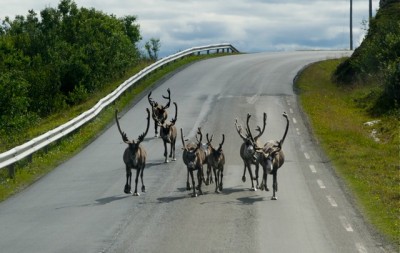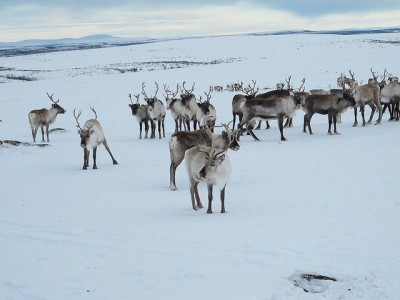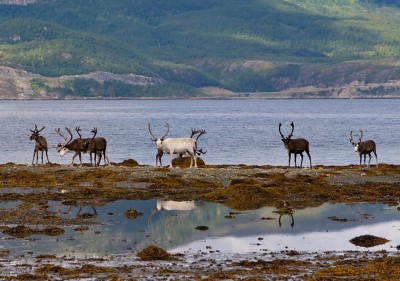Norwegian Broadcasting (NRK), which sparked international interest with its “slow TV” concept, has a new project in the works. It involves plans to follow hundreds of reindeer as their herders move them during springtime from winter grazing grounds to the coast.

It’s common when driving along Norway’s Arctic coast of Finnmark to encounter reindeer along the road during the summer. From late spring to early autumn, the reindeer graze right down to the beaches and even swim over to islands where the grass is literally greener.
“We want to document the journey they make from the snow-clad plateaus to springtime out on the coast,” Ole Rune Hætta of NRK Sami in Karasjok told newspaper Aftenposten.
“Ideally, the reindeer will be filmed while swimming in the sea, over a sound, to summer grazing land,” Hætta added. “That would be a fantastic ending to the broadcast.”

Thomas Hellum, project leader for NRK’s sakte-TV (slow TV) where it all began in Hordaland, said the state broadcaster’s “dream scenario’ calls for around 15 to 20 NRK staffers to closely follow the reindeer and their Sami owners and herders over a seven-day period sometime between April 1 and May 10, and broadcast it all minute-by-minute on NRK’s Channel 2 in 2017. NRK2, Hætta said, would need to be flexible regarding its regular programming.
NRK is now looking for a reindeer-owning family willing to take part in the project, since it would involve constant filming, up close and personal, over an extended period.
“Something that would have to be arranged first and foremost is to find a herd of reindeer that can start the trip from winter grazing areas to the coast on command,” Hætta said, “and even if it’s technically possible to do that.”

The annual migration of the reindeer doesn’t occur in accordance with a set schedule. Its starting point varies, depending on weather and snow conditions, and the reindeer often set their own course over the vast expanses of the mountains and the plateau known as Finnmarksvidda. The reindeer’s journey to the sea mostly takes place in areas with no roads or other infrastructure. Practical challenges thus abound.
NRK thinks it’s a great idea, though, as it continues to develop slow-TV programs launched with great success in 2009, when it first tracked the journey of a train between Bergen and Oslo minute-by-minute. That program attracted huge interest nationwide, as Norwegians sat down for hours, mesmerized by the quiet, relaxing pace and interesting information broadcast along the way.
NRK followed that up with smashing success two years later, when it mounted cameras all over one of the Hurtigruten ships that ply the Norwegian coast between Bergen in the south and Kirkenes in the north. The program lasted without interruption for the entire five days of the journey and ratings soared, this time also drawing local residents and boaters to the ship as it docked at myriad small ports during the trip north. It all turned into a cultural phenomenon that united the country in many ways during that one voyage in unusually sunny and clear weather in June 2011, eerily enough just before Norwegians were stunned by the deadly attacks carried out by a lone gunman just a month later.
Various other slow-TV projects have followed, from a ride on the trainline between Trondheim and Bodø to a program set inside a church during which various choirs sang their way through the entire hymnbook. The concept has been sold to many other countries, with the BBC, the Travel Channel and other broadcasters creating their own versions or showing some of NRK’s programs.
The reindeer project is perhaps the most ambitious yet, with the wildcard being whether producers can arrange the sheer technical infrastructure needed. “Everything else, like have 15 to 20 staffers working outdoors and on the move around the clock for seven days, we can always figure out,” Hellem told Aftenposten. A TV control room, for example, would probably need to be set up in a so-called gumpi, described as a rather claustrophobic mini-camping van mounted on skis and towed by a snowmobile. Fastening mobile cameras to the lead reindeer in the flock poses another challenges, along with finding batteries that can tolerate extreme conditions in an area where temperatures can drop to minus-20C even in springtime. It was also unclear whether the cameras might disturb the reindeer.
‘Unique and important story’
Nils Mikkel Somby, a reindeer owner from Karasjok, strongly supports NRK’s plans but cautions that even more challenges can arise. “There can be a lot of waiting that may be boring for viewers,” he told Aftenposten, noting that the reindeer can suddenly and without warning decide to take a break, sit down in the snow and stay there for two or three hours until they decide to start moving again. His family moves their herd every spring from an area southeast of Karasjok to Magerøya and the North Cape. “We use around 10 to 12 days for the trip,” Somby said. “It’s not possible to make it any shorter.”
Hellum seemed undaunted by the challenges. “Following the reindeer over the Finnmark plateau would be spectatcular for incredibly many viewers in Norway, and it will certainly rouse interest abroad,” he said. “It’s a unique and important story from Norwegian and Sami reality, made to be told in real time.”
newsinenglish.no/Nina Berglund

